In the past two segments on children’s gardens, I’ve focused on creating comfort, amazing options, and playing house. Now I have a few more areas to explore.
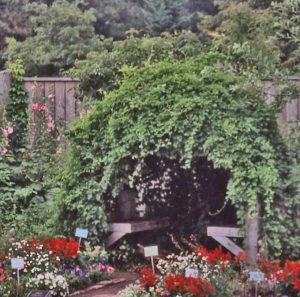
A vine-covered arch makes a great hide-away for children.
Dream Time: Fear for their children’s safety has become such an issue that many parents are afraid to let their kids out of their sight these days. While understandable, this concern often results in children having very little privacy. With a little creative thinking and a touch of imagination, however, parents can give their kids a safe, private retreat in their own back yard. Consider building a makeshift bamboo fort for children. Although most bamboo can easily become a homeowner’s worst maintenance nightmare, this is not true of Fargesia nitida (Fountain Bamboo), a clumping bamboo. Using four of these plants as the corners and tying the tops on the diagonal, you could create an airy refuge for children.
Installing a small covered arbor with built-in seats that could be used for reading and dreaming, particularly if the seats have cushions covered in weather-resistant material, would be another way of providing children with a little privacy and shade.
Our children’s lives are so structured that we don’t leave them enough time for dreaming. Doing nothing is not a waste of time; it is an opportunity to think about one’s universe.
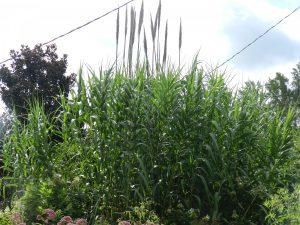
For a jungle look, try planting a tall grass with bold foliage like Arundo donax or Pennisetum setaceum ‘Prince’.
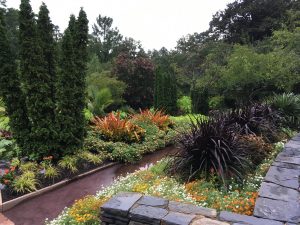
Pennisetum setaceum ‘Prince’
Sense and Sensibility: Adding interesting plant material can introduce a little childlike whimsy to the garden as well. Children are fascinated by textures, and a bold perennial grass like Arundo donax (Giant Reed) and one of the annual grasses like Pennisetum setaceum ‘Prince’ (Elephant Grass) look and feel like large cornstalks. For clients with small children, a grouping could be planted to a create a “jungle” for juvenile explorers while screening out a neighbor’s garage or an unsightly view. Don’t forget to supply child-sized pith helmets!
Soft, furry foliage is also appealing to children. Stacys byzantina (Lamb’s Ears), an easy-to-grow perennial that requires very little maintenance, has woolly, silver foliage that children love to touch. It grows best in hot, sunny dry sites (with good drainage) that are frequently considered a challenge. Choose one of the cultivars, such as ‘Silver Carpet’ or ‘Big Ears’, that do not flower in order to cut down on maintenance. If your client likes country chic, a lamb sculpture placed among the planting would be a fun decoration. Depending on size, children could even pretend to be riding the lamb. An easy annual like Chenille Plant (Acalypha hispida) would appeal to children because it has fuzzy, red, catkin-like blooms.
Many of us enjoy gardening, and it is easy to bring our children into the garden and let them plant seeds. The trick is choosing seed that grows into plants they will particularly enjoy. Nigella (Love-in-a-Mist) is beautiful when it blooms but what appeals to children are the strange-looking pods. Parents can teach their kids to shake the pod while still on the plant, letting them know that when it rattles, it can be cut. When it’s ready, the kids can pinch the pod and sprinkle seeds throughout the garden. This is also true of Aquilegia (Columbine).
For those clients who have limited space, a pizza garden, consisting of tomatoes, basil, and peppers, can be planted in a container. The pizza won’t be complete without cheese but in small spaces, it’s difficult to find room for a cow! Our children are so accustomed to ordering and eating pizza that they never think about where the ingredients come from; this would provide yet another teaching opportunity for parents.
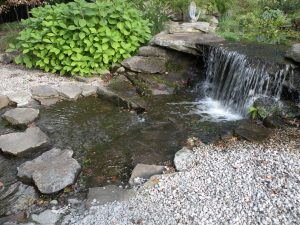
Waterfall and stream with stepping stones through stream at back of house
And who isn’t entranced by water? Adding a water feature to a client’s property can be as easy as designing a shallow stream or pond. One idea involves placing large, flat stepping stones or constructed “lily pads” through the water so that walking on them becomes an adventure. Parents can count on the fact the children will “accidentally” fall in, especially on really hot days. If the structure is large enough, a bridge can also be included. Chances are that tree toads, butterflies, and birds will also be attracted to the water, thus tickling children’s sense of wonder, as well as acquainting them with fauna that live somewhere other than the zoo.
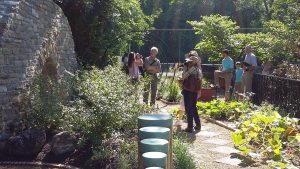
This drum “set” was designed by Cincinnati’s Bill Ripley for a couple with children who didn’t want the usual playset.
Children are also fascinated by sound. Casa Loma, a castle in Toronto, features the large Dragon Tree Bell, which children delight in ringing. A series of smaller sculptures and bells can be placed throughout a landscape so that kids can run from one to another, or they can be placed side by side. In either case, varying the sounds of the bells can help small visitors learn about creating music. A series of drums would also be a fun feature for kids.
Designing a landscape that includes fun features for children and a sense of refinement for adults is not always easy. However, it is not impossible. Although I am sure that there are a multitude of other ideas that would make landscapes pleasant for all, these suggestions can help get playtime off to a good start.


1 Comment